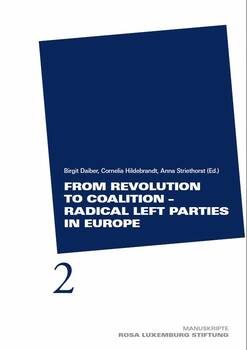
Preface for the Arab edition by Peter Schäfer
Since 2008, we – the Brussels Office and the Institute for Social Analysis of the Rosa Luxemburg Foundation – have been working to compile reports on the left parties of Europe. This is now our second publication on the topic. We published an initial compilation of country reports in the spring of 2009, which left many questions unanswered, and also provided no comparisons between the parties. This prompted us in the summer of 2009 to organize a meeting of authors, and to draft a list of questions for more thorough-going reports. Thus, we felt, it should be possible to analyse the situation of the left parties in Europe in a comparative manner. Initially, this investigation was completed in May 2010 and published in German, but delays in the translation and events in the countries involved made the English version obsolete before it was even finished. As a result, the texts have now been updated to cover events through the end of 2011. All 25 reports will be released internationally at the same time, as a compiled volume in the rls Position Papers Series.
The political spectrum of left parties in Europe ranges from social democratic, leftlibertarian and green-alternative formations to classical communist parties. We have limited our investigation to those left-wing parties which, according to their own self-image, belong to the political left, but neither to the social democratic nor to the green-alternative family. We refer to these parties as the «left parties». A total of some 60 parties can be considered part of this party family. As one of the few verifiable criteria for the selection of these parties, we have used their membership in one of the relevant European cooperative networks, specifically the European Left (EL), the New European Left Forum (NELF) and the Alliance of the Nordic Green Left (NGLA). Those parties whose elected representatives in the European Parliament adhere to the confederal Group of GUE/NGL are also included. To compare common problems and issues of party development, strategy and programme, it is necessary to use the theoretical and empirical tools of electoral and party research. These instruments have hitherto been applied to the parties discussed here in only a few cases. Comparative (western) European research on the development of the political systems in western and east-central Europe generally treats radical left parties – to the extent that they are politically relevant – as part of the left spectrum, without addressing their own development in any detail. Therefore, this publication is an attempt to enter into a comparative discussion of the development of radical left parties in Europe without as yet satisfying the demand for a well-grounded research effort of these parties.
The present anthology includes 23 country reports, one of which is on all the countries of former Yugoslavia, and two of which are about Italy. For some European countries, we have not been able to provide any analysis, since we were unable to find suitable authors within the required time frame. In some, we originally had reports, but were unable to get new ones for the present 2010/’eleven publication. The questionnaire developed for the country reports referred to the development of the parties, their political concepts and their self-understanding, their organisational structures, strategies and programmes, as well as their current use value in the political structure of the respective countries. Here, the focus of the authors of the different reports is again very different. There are several reasons for this: First, the national frameworks differ widely; second, there are also significant differences in their political traditions and goals; and finally, many of the parties are too small to allow for any meaningful statements about the social composition of their memberships. Hence, the country reports present differing segments of the histories and current situations of radical left parties.
The main focus of our interest was and is the question of the potentials of radical left-wing parties and their chances for breaking out of the predominantly defensive position that has prevailed since 1989: Under what conditions do radical leftist parties compete successfully in the political spectrums in their countries? What is the role of programme and self-image? To what extent are the parties in a position to bring together actors from various left tendencies? And, beyond that: to what extent are they able to bind various sub-cultures to themselves, and to create alliances to push through leftist demands? Do the parties concerned in fact address the building of counter-hegemonic societal alliances – or do they prefer to stay within their own «camps»? What answers do they provide to the existential issues of European development? And where can we find examples of transformational projects of a forwardlooking character?
We hope to be able to provide answers to some aspects of these questions in our study, and thus to not only contribute to a better understanding of radical left-wing parties in Europe, but also to help spark some thought about their ability to act in a Europe of the future. The existential problems in Europe and the world, the global crises, climate change, the social political changes in Europe and elsewhere, and the growing number of regional wars call for left responses and common strategies.
We would like to express our thanks to the authors of the country studies, particularly for rewriting and updating their papers for the English edition, and to our translator
Phil Hill for incorporating these changes into the final version. Finally, we would especially like to thank the European Left Party and the European Foundation transform! Europe, the European network for alternative thinking and political dialogue – the most important actors in the development of common strategies.
Berlin, November 2011